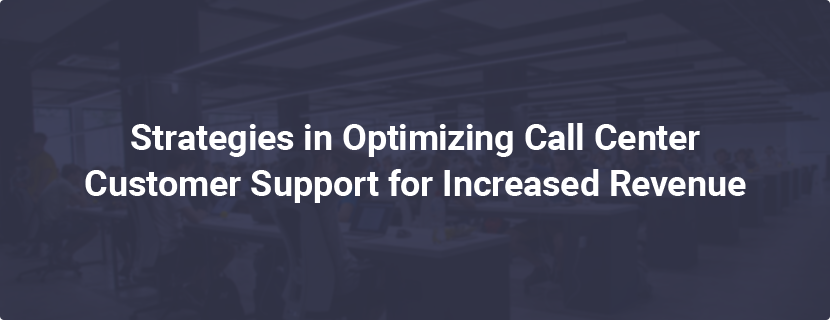
Organizational success and long-term growth primarily depends on customer satisfaction and loyalty, and customer service has always supported corporate growth by keeping customers happy and ensuring their ongoing loyalty. With evolving customer expectations and service complexities, contact centers are poised to deliver strategic value and profitability to organizations. Many customer service departments are actively implementing strategies, enabling their companies to achieve healthy growth in the face of challenging market conditions and intense competition. The first step in creating a revenue-generating customer service organization is to determine which strategy or strategies are most applicable to your business today.
Customer centricity is not just about offering great customer service, it means offering a great experience from the awareness stage, through the purchasing process and finally through the post-purchase process. It’s a strategy that’s based on putting your customer first, and at the core of your business. According to the Customers 2020 Report, by 2020, customer experience will overtake price and product as the key brand differentiator. However, executing a customer-centric strategy doesn’t happen overnight, and it has to be guided by a well-laid out customer centric business strategy.

Establishing a Customer-First Mindset without Sacrificing Efficiency
For companies looking to establish a customer-first mindset at their call center, the essential part is to understand the customers in terms of their interests, behavior and needs. A research by Deloitte and Touche found that customer-centric companies were 60% more profitable compared to companies that were not focused on the customer. A study from NewVoiceMedia indicates that companies lose more than $62 billion due to poor customer service. No company can afford to be a customer service laggard.
According to Forrester, 72% of businesses say that improving the customer experience is their top priority. Both Amazon and Zappos are prime examples of brands that are customer centric and have spent years creating a culture around the customer and their needs. This is so important that organizations like Oracle developed a Chief Customer Officer (CCO) to ensure a consistently amazing customer experience across all touch points.
Companies such as Apple, Samsung, Google and GE are just a few examples of customer-centric business models. These businesses strive to identify what their customers want, and do their utmost to fulfill their needs, wants and requirements with the products and services that they offer. These businesses also excel in customer-care and after-sales service. However, most companies do not have all of the components in place to claim they are customer centric. By designing the company from the customer’s perspective, the organization will be focused on the customer’s needs.
A customer first strategy needs an organization to re-center itself behind this company-wide objective. It can make a real difference in terms of both sales and profits to those who follow this direction. But it is essential to have executive support and true commitment from every employee to think customer first. Creating a customer-first culture that your entire organization embraces makes all the difference in how your brand is perceived by customers.
Businesses need to bolster their customer interaction and create a regular dialogue with customers. Don’t send an annual survey to see if they’re satisfied with your products, contact center or delivery performance. Talk to them regularly at key points in your relationship with them – when they’ve made a purchase, called your contact center or canceled an order. If you arm yourself with the tools to better understand your customers, you will be better able to act in their best interests. Talking to customers at regular intervals is not simply about monitoring progress; it is a core part of becoming a business that listens to its customers.
Tap this knowledge base to better understand employee views. When listening to the voice of the customer, remember to include and share the positive feedback. Acting on negative feedback will strengthen customer engagement and sharing and acting on positive feedback will strengthen employee engagement. Share responsibility and construct a common goal. Just as change must be demonstrated, employees also should be empowered to take action where necessary in order to be a part of building the culture. Corporate culture is a long-term consideration and demonstrating that you’re truly investing in change will help to drive further change and engage your employees in the process. To engage employees you must make changes and demonstrate what you’re doing. Where customers and employees are telling you that you could be doing something better, take action and rebuild the processes.
Staffing Adjustments
While customer service departments can drive significant revenue opportunities without any staffing changes, companies seeking to maximize top-line gains typically wind up modifying their training and hiring practices to one degree or another. Hiring practices, for example, may shift as you start looking for people who have good problem-solving skills and some evidence of sales aptitude. Supplemental training may also be required to help staff recognize lead opportunities or to teach them how to close transactions.

Accurately forecasting the demand for your work force is critical for call center success. Understaffing increases customer attrition and over-staffing increases costs. By predicting the number of agents required at any point of time, call centers can optimize workforce and cost. The challenge is to identify peaks and troughs of inbound call volume and to assign agents accordingly. The process becomes increasingly difficult as you add internal and external variables, many of which are beyond your control. Mix in the random nature of call arrivals and the ordinary variability of human performance and the magnitude of the task can be huge. And although it may sound strange, small and midsized centers are generally even harder to manage than larger centers.
Reduction in administrative hours to develop forecast and schedules – Using a forecasting and scheduling solution can reduce administrative time spent developing forecasts and schedules by up to 90 percent.
Reduction in excessive agent idle time – A huge payback can be quickly realized when agent schedules are more closely aligned with call demand. Software is much better suited to the schedule generation task, because computers can assess hundreds of different sets of agent schedules in minutes.
Reduction in agent turnover – By matching workload and the workforce, the call center experiences less service level volatility, leading to a more predictable work experience for the agents. By involving agents in the scheduling process, agents are empowered to play a greater role in their work/life balance, further aided by shift swapping and work preferences.
Improved agent productivity – With more time available to front-line management, productivity improvements from focused coaching are realized.
Training – According to the “Emerging Workforce Study”, 41% of employees plan to leave organizations with a “poor” training score as opposed to just 12% for those organizations with a rating of “good”. With in-depth training sessions through e-learning, virtual assistance, and scripting tools, clearly establish company goals and expectations and provide your agents the confidence to tackle any initiative. Bring top-performing agents to training. Encourage your top agents to come to trainings and give practical tips on how to be a top performer. This will set the bar high for new hires and enhance their insight into how to effectively execute their job. Keeping the agents updated with new methods and process trainings is something that has to be done continually. According to The Global Call Center Report, experienced call center agents receive an average of six training days per year. Make sure your agents keep their performance high by continually providing refresher courses, training on new products or software and training to enhance their professional development.
Experiment with Team Structure – We increasingly need to recruit people to integrate into a fast-paced team: according to McKinsey, 40% of jobs in developed economies involve a high degree of collaboration. Switch your agents tasks on occasion, encourage collaboration, and create team-building exercises. It will facilitate agent enthusiasm and interest, while keeping them on their toes. Communication and sharing of knowledge between individuals has a huge impact on customer service performance: the happier an employee is in their environment, the more engaged that person will be in his or her day-to-day job. More and more companies are using data-driven personality testing to help them in these crucial managerial decisions.
Updated Technology Solutions
Customer service departments are most effective at generating revenue when they have the right technology. To provide the customer data necessary to fulfill an aggressive mining strategy, for example, it’s vital to have a CRM system in place that captures relevant information across all communication channels. To ensure that leads generated by a real-time referral strategy are used to maximum effect, integration between your contact center system and your sales management system is essential. Your system needs to be equipped with the needed technology and tools. If you are developing a customer support system then it should be intuitive and accurate. According to Gartner “Contact center infrastructure and CRM functionalities are increasingly integrating, and sometimes competing, to deliver customer engagement capabilities. Application leaders responsible for contact centers must match investment planning with operational and business goals”.
In the recent times, the call center solutions hosted on cloud such as, virtual call centers, IVRs, cloud hosted dialers have changed the scenario, substantially. With the help of these solutions, today’s customer support system has become well equipped and customer centric. Much of the recent hype has been around cloud computing. Customer orientation and product innovations have promoted the inclination towards service-based architecture. It is an increasingly popular choice for organizations that want to avoid a major up-front investment or just appreciate the flexibility of the cloud-based model. Wikibon predicted that enterprise cloud spending is growing at a 16% compound annual growth (CAGR) run rate between 2016 and 2026.
It is a well-known fact that almost 95% of the customers use more than one channel to communicate with companies, and this trend is here to stay. Today clients can communicate using multiple methods such as web, mail, chat, phone, e-mail, text, etc. Companies need to provide multiple channels for clients to communicate in the coming year as well, and make customer interaction more convenient for them. Strong growth is expected in web chat and social media customer service interactions, with email volumes still predicted to grow although at a lesser rate.
AI algorithms are challenging human intelligence. With their inherent pattern recognition, self-learning and cognitive capabilities, AI powered algorithms have the ability to perform complex jobs with speed and accuracy. Businesses are getting deeper into predictive analytics, using artificial intelligence (AI) applications to help streamline call center experiences for customers and agents.
Chatbots are gaining popularity due to recent trends in mobile messaging. Most recently, we’ve seen an explosion of chatbot development in 2016 due to breakthroughs in artificial intelligence and changing demographics. Mobile customer care will see a huge rise in the coming years, especially in the e-commerce business.
The following emerging technology areas are likely to become prominent in coming times:
- Behavioral routing software that matches call-center agents with customers by personality and behavioral characteristics
- Artificial-intelligence agents, powered by advanced machine-learning methods, that customers can query—without human intervention
- Visualization technologies that permit enhanced interaction between live agents and customers
With better technology, call centers can increase efficiency, engage and empower employees, and deliver best-in-class customer experiences.

Importance of Performance Measurement and Data Analysis
Because call centers are the operational frontline for many companies, they require careful monitoring to determine their ability to effectively provide service and support to callers. This requires tracking and measuring call center metrics and key performance indicators to evaluate both agent and call center performance. Call centers have to constantly work to improve their key performance metrics. From average handle time, to call resolutions, to customer experience, call center managers have an enormous challenge before them to make continuous improvements.
Call center managers seeking to propel their call center ahead of the competition, wow their callers with an awesome customer experience, increase revenue and reduce costs should make an effort to identify relevant call center KPIs, measure them consistently and act on the results. Doing so will allow them to make more informed decisions that will have a measurable impact on their call center’s performance.
Without proper performance metrics in place, contact centers miss out valuable opportunities to drive customer service excellence that results in a better customer experience overall. The metrics your center embraces have an impact on the customer experience that simply can’t be ignored. Of course, not every metric can be completely customer-centric — there are operations costs and business needs that must also be considered — focusing strictly on straight productivity metrics and managing a contact center primarily as a cost center simply is no longer feasible.
Emphasizing and balancing the view of the metrics here will ensure that your company keeps customer satisfaction and loyalty high while enabling your center to be an efficient, high-performing, critical business entity.
Call centers do not work in a vacuum. Rather, they are closely linked with sales, marketing, manufacturing, and nearly every other department within an organization, as well as being a key customer touch point. What happens or doesn’t happen in a call center can enable a company to achieve greater success just as it can seriously tarnish a brand.
When preparing to make improvements, call center managers need reliable information. Without the right information, a call center’s management staff might as well try to work blindfolded.
This is where big data and predictive analytics come into play. The most-common complaints about call centers are the duration of being on hold, slow turnaround times, having to explain an issue multiple times to different agents, and lack of a satisfactory resolution. By analyzing all of the available call center customer data, you’ll be able to quickly locate flaws in your process, and improve upon the advantages that your call center is already offering. As a result, your clients will be able to get the solutions they need, as quickly and easily as they could ever want. There’s nothing more valuable than taking what is generally associated with as a negative product experience to an overwhelmingly smooth, and potentially pleasant, interaction.
Evaluation through metrics and monitoring is essential for every call center. Data collected and evaluated can not only enable improvements to be made to the customer experience, it can also reduce operational costs and lower employee turnover.
Conclusion
A recent report “Collapse of the Cost Center: Driving Contact Center Profitability,” released by Zendesk in partnership with the International Customer Management Institute (ICMI), however, suggests that call centers need to do more to prove their value to the organization as a whole.
It shows that while thinking is changing within the organization, it is still slow moving in some aspects. For instance, more than 62 percent of call centers are still considered cost centers, and only 27 percent of call centers are measuring and reporting on their service levels the right way. If call centers step up their efforts and demonstrate the value they bring, it could go a long way toward improving their ability to gain more resources and tools to improve outcomes.
By uncovering the opportunities to increase efficiencies, customer experiences, and strategic insights, contact center leaders can move beyond cost center perceptions and towards profit center pleasures. It actually costs six or seven times more, on average, to gain a new customer than it does to keep one that already exists. Additionally, repeat customers tend to spend more, increasing your revenue organically. In ecommerce, for example, while new customers spend an average of just under $25, returning customers average closer to $50. It pays to keep customers coming back for more by providing helpful sales support and a troubleshooting team that’s able to efficiently solve any issue at hand. One of the best ways to guarantee a steady flow of returning customers is to ensure that you have a solid, reliable and helpful customer support team, system and tools in place. In other words, the better your customer support, the more revenue you’ll drive.
Source: https://www.tenfold.com/what-is/optimizing-call-center-customer-support-increased-revenue




